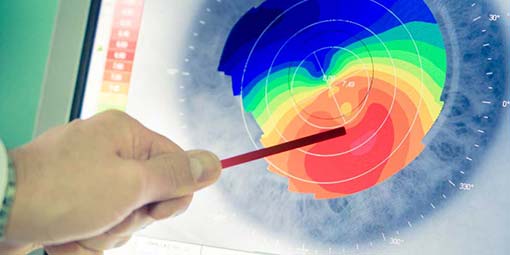Custom Contact Lens Fitting
13-04-2022
When it comes to contact lenses, one size doesn't fit all. If the curvature of a contact lens is too flat or too steep for and individual's eye's shape, they could experience discomfort or even damage to their eye. Therefore, optometrists and opticians perform a number of measurements and evaluations to custom fit contact lenses to individuals. It should be noted that not all optometrists and opticians have extensive experience custom fitting contact lenses. Accordingly, if one has particularly unique needs, they should ensure they have an experience professional assisting them. Some of the measurements and evaluations that will be performed to custom fit contact lenses include:
Cornea Measurements
An instrument called a keratometer (or corneal topographer) is used to measure the curvature of the cornea. The keratometer analyzes light reflections from your cornea and determines the curvature of your eye's surface. These measurements determine the proper curve and size of contact lenses needed for a patient. Because a keratometer measures only a small, limited section of the cornea, additional computerized measurements of the cornea are often performed using an automated instrument called a corneal topographer. Corneal topography provides extremely precise details about surface characteristics of the entire cornea. Similar to the keratometer, it accomplishes this by measuring how the device's light reflects off the eye. If an individual's eye surface is determined to be somewhat irregular because of astigmatism, they may require a special contact lens known as a toric contact lens that is shaped to offset distortions of your eye to provide sharper vision.Pupil and Iris Measurements.
The size of an individual\'s pupil is measured by holding a reference card of different pupil sizes next to the eye to determine the best match. Automated instruments that measure pupil size also exist. These instruments are capable of extremely precise measurements, and some simultaneously measure the horizontal and vertical diameter of your pupil. Similar technologies also may be used to measure the diameter of the colored portion of your eye (iris). Pupil and iris measurements help determine the contact lenses that will best fit and look on an individual's eyes.Tear Film Evaluation.
Contact lens fittings using include a tear film evaluation. The ability of the body to produce tears can be evaluated through use of small strip of paper inserted underneath the lower eyelid. The test requires the patient to close their eyes for approximately five minutes, and then the paper is removed. The length of the paper moistened by your tears is measured to assess your tear production and to determine if the patient has dry eyes. Another method commonly used to detect dry eyes involves adding dye to the tear layer on your eye via eye drops or a moistened paper strip and then evaluating how long it takes for tears to evaporate. If a patient possesses a severe dry eye condition, they may have to avoid or discontinue contact lens use.Eye Surface Evaluation & Contact Lens Fit.
The health of the cornea will is evaluated using a slit lamp, or biomicroscope. This lighted instrument provides a highly magnified view of the cornea and other tissues, helping optometrists to evaluate the health of the front of the eyes and detect any changes caused by contact lens wear. The slit lamp is also used to evaluate the fit of a trial contact lens because it enables your doctor to observe the alignment and movement of the lens as it rests on the surface of your eye. In follow-up visits, the optometrist may stain your eye with dye to detect defects and ensure that the contact lenses are not damaging the eye's surface. A patient will typically need to remove their contact lenses before this test is performed.It can take two to three follow-up visits to complete an uncomplicated contact lens fitting. Afterwards, one should schedule annual contact lens exams so their optometrist can monitor their eye health and changes to their prescription.
Due to the health risks that poorly fitting contact lenses represent, in Alberta, a contact lens prescription is valid for one year only.
Schedule An Appointment